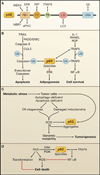p62 at the crossroads of autophagy, apoptosis, and cancer
- PMID: 19524504
- PMCID: PMC3971861
- DOI: 10.1016/j.cell.2009.05.023
p62 at the crossroads of autophagy, apoptosis, and cancer
Abstract
The signaling adaptor p62 is a multidomain protein implicated in the activation of the transcription factor NF-kappaB. Recent findings link p62 activity to the extrinsic apoptosis pathway, and Mathew et al. (2009) now show that the modulation of p62 by autophagy is a key factor in tumorigenesis. These findings place p62 at critical decision points that control cell death and survival.
Figures

References
-
- Duran A, Serrano M, Leitges M, Flores JM, Picard S, Brown JP, Moscat J, Diaz-Meco MT. Dev. Cell. 2004;6:303–309. - PubMed
-
- Duran A, Linares JF, Galvez AS, Wikenheiser K, Flores JM, Diaz-Meco MT, Moscat J. Cancer Cell. 2008;13:343–354. - PubMed
-
- Geetha T, Jiang J, Wooten MW. Mol. Cell. 2005;20:301–312. - PubMed
-
- Jin Z, Li Y, Pitti R, Lawrence D, Pham V, Lill J, Ashkenazi A. Cell. 2009;137:721–735. - PubMed
Publication types
MeSH terms
Substances
Grants and funding
LinkOut - more resources
Full Text Sources
Other Literature Sources
Medical

